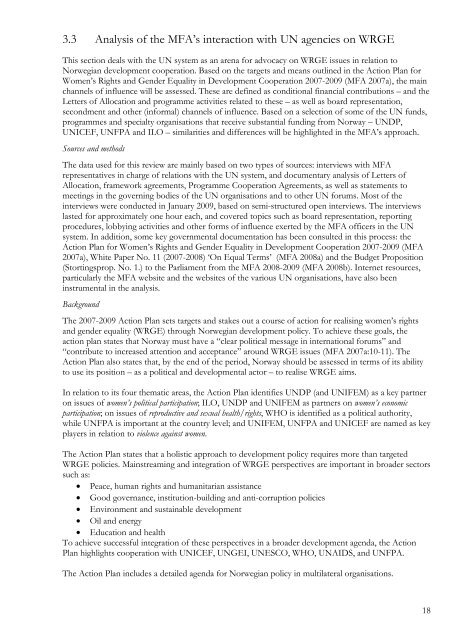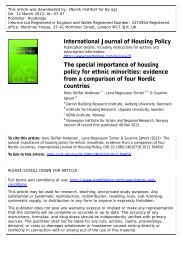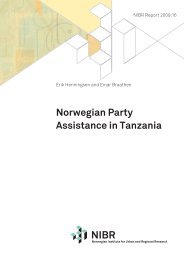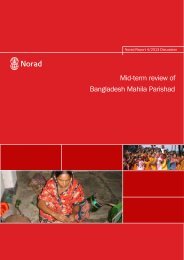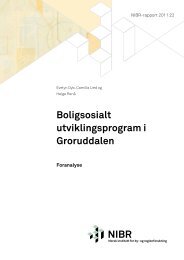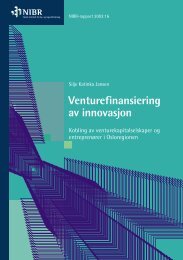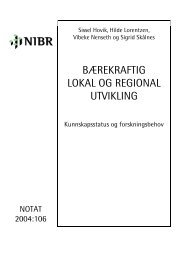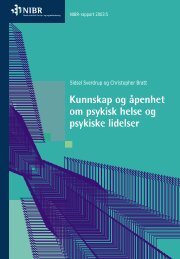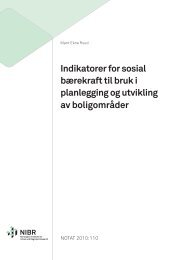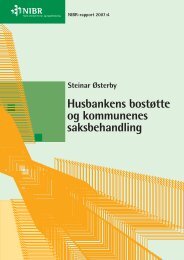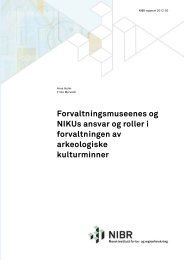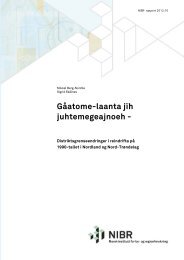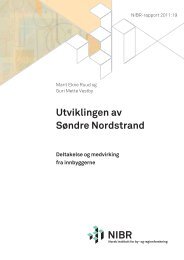Mid-Term Review of the Norwegian Action Plan for Women's ... - Norad
Mid-Term Review of the Norwegian Action Plan for Women's ... - Norad
Mid-Term Review of the Norwegian Action Plan for Women's ... - Norad
You also want an ePaper? Increase the reach of your titles
YUMPU automatically turns print PDFs into web optimized ePapers that Google loves.
3.3 Analysis <strong>of</strong> <strong>the</strong> MFA’s interaction with UN agencies on WRGEThis section deals with <strong>the</strong> UN system as an arena <strong>for</strong> advocacy on WRGE issues in relation to<strong>Norwegian</strong> development cooperation. Based on <strong>the</strong> targets and means outlined in <strong>the</strong> <strong>Action</strong> <strong>Plan</strong> <strong>for</strong>Women’s Rights and Gender Equality in Development Cooperation 2007-2009 (MFA 2007a), <strong>the</strong> mainchannels <strong>of</strong> influence will be assessed. These are defined as conditional financial contributions – and <strong>the</strong>Letters <strong>of</strong> Allocation and programme activities related to <strong>the</strong>se – as well as board representation,secondment and o<strong>the</strong>r (in<strong>for</strong>mal) channels <strong>of</strong> influence. Based on a selection <strong>of</strong> some <strong>of</strong> <strong>the</strong> UN funds,programmes and specialty organisations that receive substantial funding from Norway – UNDP,UNICEF, UNFPA and ILO – similarities and differences will be highlighted in <strong>the</strong> MFA’s approach.Sources and methodsThe data used <strong>for</strong> this review are mainly based on two types <strong>of</strong> sources: interviews with MFArepresentatives in charge <strong>of</strong> relations with <strong>the</strong> UN system, and documentary analysis <strong>of</strong> Letters <strong>of</strong>Allocation, framework agreements, Programme Cooperation Agreements, as well as statements tomeetings in <strong>the</strong> governing bodies <strong>of</strong> <strong>the</strong> UN organisations and to o<strong>the</strong>r UN <strong>for</strong>ums. Most <strong>of</strong> <strong>the</strong>interviews were conducted in January 2009, based on semi-structured open interviews. The interviewslasted <strong>for</strong> approximately one hour each, and covered topics such as board representation, reportingprocedures, lobbying activities and o<strong>the</strong>r <strong>for</strong>ms <strong>of</strong> influence exerted by <strong>the</strong> MFA <strong>of</strong>ficers in <strong>the</strong> UNsystem. In addition, some key governmental documentation has been consulted in this process: <strong>the</strong><strong>Action</strong> <strong>Plan</strong> <strong>for</strong> Women’s Rights and Gender Equality in Development Cooperation 2007-2009 (MFA2007a), White Paper No. 11 (2007-2008) ‘On Equal <strong>Term</strong>s’ (MFA 2008a) and <strong>the</strong> Budget Proposition(Stortingsprop. No. 1.) to <strong>the</strong> Parliament from <strong>the</strong> MFA 2008-2009 (MFA 2008b). Internet resources,particularly <strong>the</strong> MFA website and <strong>the</strong> websites <strong>of</strong> <strong>the</strong> various UN organisations, have also beeninstrumental in <strong>the</strong> analysis.BackgroundThe 2007-2009 <strong>Action</strong> <strong>Plan</strong> sets targets and stakes out a course <strong>of</strong> action <strong>for</strong> realising women’s rightsand gender equality (WRGE) through <strong>Norwegian</strong> development policy. To achieve <strong>the</strong>se goals, <strong>the</strong>action plan states that Norway must have a “clear political message in international <strong>for</strong>ums” and“contribute to increased attention and acceptance” around WRGE issues (MFA 2007a:10-11). The<strong>Action</strong> <strong>Plan</strong> also states that, by <strong>the</strong> end <strong>of</strong> <strong>the</strong> period, Norway should be assessed in terms <strong>of</strong> its abilityto use its position – as a political and developmental actor – to realise WRGE aims.In relation to its four <strong>the</strong>matic areas, <strong>the</strong> <strong>Action</strong> <strong>Plan</strong> identifies UNDP (and UNIFEM) as a key partneron issues <strong>of</strong> women’s political participation; ILO, UNDP and UNIFEM as partners on women’s economicparticipation; on issues <strong>of</strong> reproductive and sexual health/rights, WHO is identified as a political authority,while UNFPA is important at <strong>the</strong> country level; and UNIFEM, UNFPA and UNICEF are named as keyplayers in relation to violence against women.The <strong>Action</strong> <strong>Plan</strong> states that a holistic approach to development policy requires more than targetedWRGE policies. Mainstreaming and integration <strong>of</strong> WRGE perspectives are important in broader sectorssuch as: Peace, human rights and humanitarian assistance Good governance, institution-building and anti-corruption policies Environment and sustainable development Oil and energy Education and healthTo achieve successful integration <strong>of</strong> <strong>the</strong>se perspectives in a broader development agenda, <strong>the</strong> <strong>Action</strong><strong>Plan</strong> highlights cooperation with UNICEF, UNGEI, UNESCO, WHO, UNAIDS, and UNFPA.The <strong>Action</strong> <strong>Plan</strong> includes a detailed agenda <strong>for</strong> <strong>Norwegian</strong> policy in multilateral organisations.18


